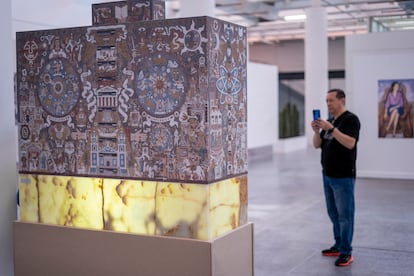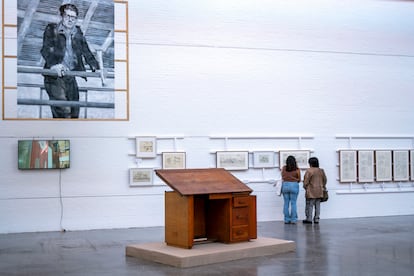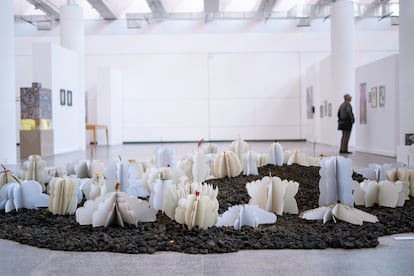The education of the Mexican working class was at the center of the concerns of the architect Juan O’Gorman (Mexico City, 1905-1982). Educating the masses in a bloody country by the revolution became an obsession for this official, to the point, that he dedicated much of his creation to the design of functional and easy -to -build schools. Many of them are still standing and the plans can be observed in an exhibition organized by the University Museum of Sciences and Arts (MUCA), which delves into the work of this socially committed artist.
It is a tribute to an architect whose work is respected in the academic field, but that has not been sufficiently sized, which has not achieved the level of recognition of other colleagues, such as Mario Pani or Luis Barragán, Pritzker Prize in 1980. “O ‘ Gorman is the first Mexican modern architect with a relevance at the level of Latin America. And that has been incorporated with some ease to the history of architecture, but not in a deeper dimension, ”explains Adriana Sandoval, director of the Nancarrow O’Gorman Foundation, which drives the exhibition.
The exhibition has been mounted in this museum that rises next to the UNAM rectory and its famous library, possibly the most important creation of O’Gorman. In the museum there is a scale representation of that portentous building, designed with the architects Gustavo Saavedra and Juan Martínez de Velasco. It is a functional structure, simple in appearance, like all the architecture created by O’Gorman. He took care of the preparation of the beautiful mural that covers the construction, which is part of the university complex designated as a World Heritage by UNESCO. “From the beginning, I had the idea of making color stones mosaics on the blind walls of the collections, with the technique that I already had well experienced. With these mosaics the library would be different from the rest of the buildings of the University City, and with this it was given Mexican character, ”explained the architect about his work.
In the exhibition you can see the letters that confirm the contract for the execution of the library, as well as the permits for the realization of the mural. There are also the planes that show how these architects had thought of a green place, with passages with buganvilias, ash, jacarandas, Lantanas. A place to think, create and grow. “Juan O’Gorman’s architecture, although it is effectively an implementation of Le Corbusier’s recipe, has a very different social sense that would open a vein to understand what is the process of assimilation of modernity in Mexico and Latin America , with the adaptation of this architectural method to a social reality of post -revolution, ”says Sandoval.

Less recognized than the sumptuous University City Library are the primary schools that O’Gorman designed, a very strong concern for the architect, which believed in social transformation through education. He was an official of the Ministry of Education and from that entity tried to promote a change for Mexican society to access knowledge. “Understand that architecture can become a fundamental tool for a post -revolutionary Mexico, which had put a blood share in the popular classes that had fought in the revolution. There was a need for the Mexican State to correct that problem. In that context, O’Gorman realizes that less is more: less expense, but more benefit and that practice takes her to the Ministry of Public Education and a consequence of that there are more schools for more children with a lower cost, ”he explains Sandoval.
Thus, the architect of the commitment leaned over his design desk to work on the production of a functional model of schools that would enroll a greater number of students. That desk – the trench from where the educational revolution was made in Mexico, as Sandoval calls it – is part of the sample, as well as the work instruments of the architect, such as its colored pencils, pencilings and rules of different scales and shapes and shapes . Here are also projects of utopian house blocks, room places for workers. There are also house models designed for artists, simple, without large spaces, but beautiful. “It is an architecture focused on the need for that sector of the population. Assume organic architecture not as a medal, but as a tool. And unlike Le Corbusier, who thought that architecture could stop the revolution because it gave workers a kind of average housing as an aspirational, O’Gorman says: No, the revolution has to do with architecture, because this architecture dignifies the Life of popular classes, ”says the curator.

Unlike other architects who achieved great fame, O’Gorman was seen in strong economic troubles. From 1948 the construction of his house begins, which he called the cave, because he won in the middle of that sea of volcanic stones that is the southern zone of Mexico City, next to the Central Campus of the UNAM. The house continued to add details until 1952, until it turned it into a utopian shelter, an escape for a world that came from its worst moment: World War II. “It is a house that more than architectural is sculptural, because part of a cave and a kind of hand in hand with nature. It is an ornamental, but habitable house for a modern subject. For criticism it was a kind of recoil, of contradiction, but what the criticism so limited did not understand is that modernity itself was in a very turbulent process and that exercises like these were given in literature, in painting, where those that those who They came to believe in modernity as a civilizational via, they realized that it had failed, ”recalls Sandoval.
O’Gorman needed to finance his daughter’s studies in the United States and decided to sell his utopian cave, but with the commitment that the buyer should keep it intact. It was not like that: the enclosure was destroyed in 1969. “That is why it is so important that this exhibition is on this site, because this site was directed many years by the person who destroyed the house, Helen Escobedo. Then generates great tension. What interests me is to say that if we talk about the destruction of the cave house as a cultural crime, a crime is not perpetuated in isolation. A crime regularly, even if he has a central actor, has accomplices, witnesses and also had the silence of an entire device that was silent before the destruction, ”criticizes the curator. In the exhibition you can see the model of what was that cave, perhaps as a last revenge of O’Gorman, the architect of the social commitment.


